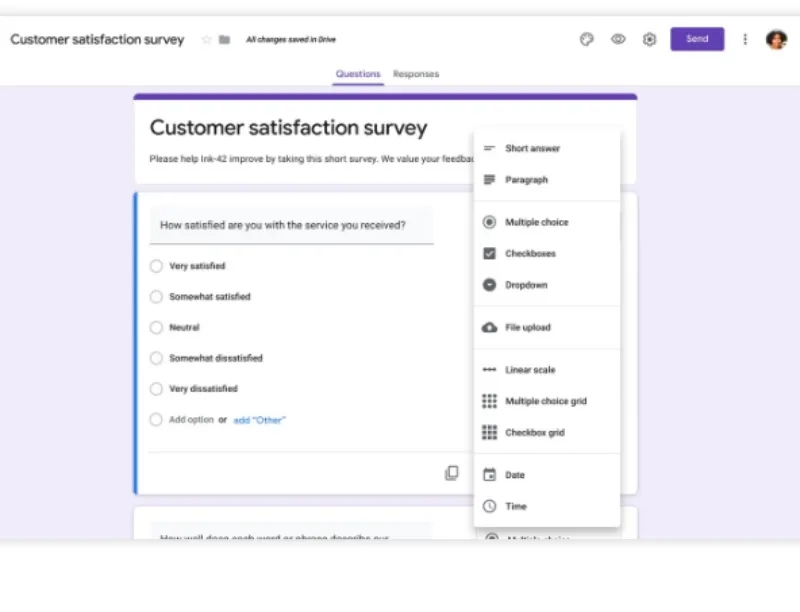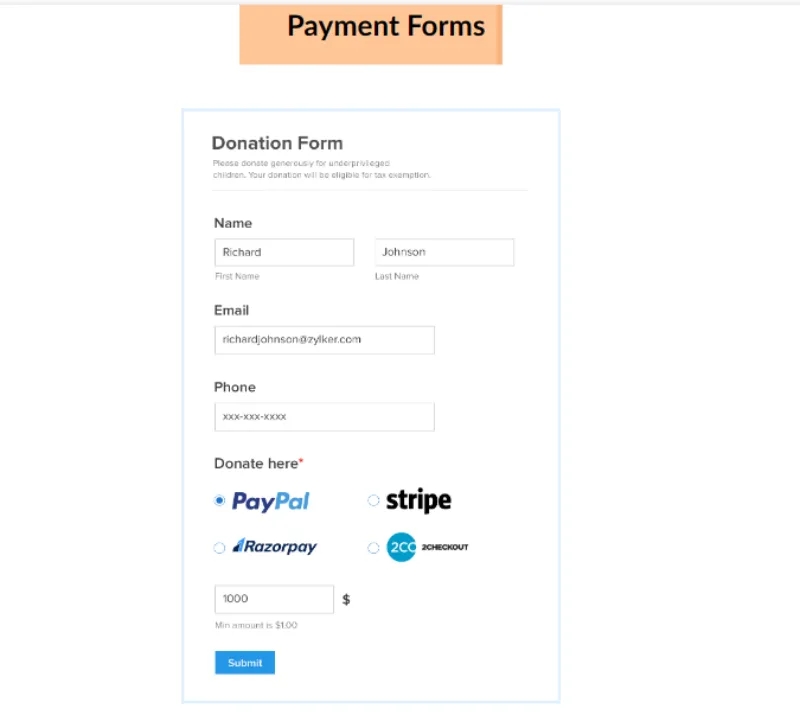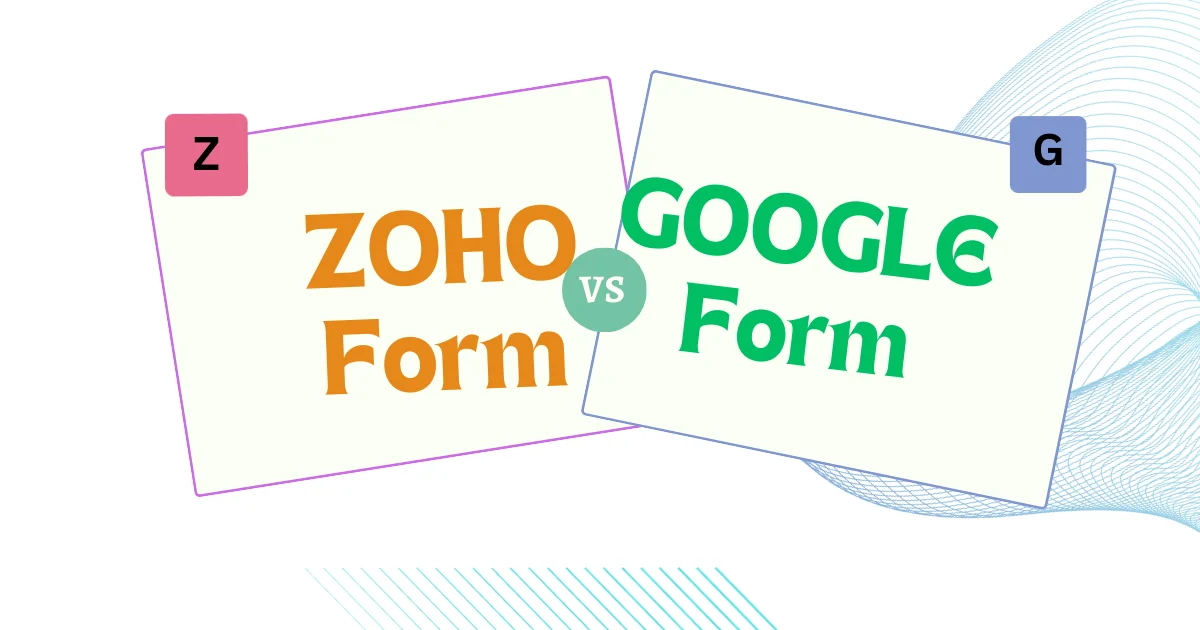Online forms are essential for various tasks, including collecting feedback, enrolling guests, and conducting surveys. A dependable online form builder is required to generate efficient online forms. Google Form and Zoho Form are two of the most popular options in this market.
What features, customization, payment, sharing and integration, notifications and tracking, responsiveness, report exporting, advanced functionality, document management, and form field options do they have in common? This post will provide a complete comparison of both platforms to assist you in determining which is the best fit for your online form requirements.
Comparative Analysis of Google and Zoho Forms
Google Forms and Zoho Forms are popular online survey and form-building applications that help businesses and individuals collect data, collect feedback, and expedite information-gathering procedures. These web-based systems are user-friendly and include a variety of capabilities for designing, distributing, and analyzing forms and surveys.
While both serve the essential objective of form development, their ecosystems, customization choices, integration capabilities, and pricing structures differ. This analytical overview will look at the essential features of Google Forms and Zoho Forms, outlining their strengths and weaknesses to help you decide on your needs.
Overview of Google and Zoho Form
Google Form and Zoho Form are both web-based form builders. However, they differ in terms of functionality and benefits. Let’s go over each one quickly.

Google Form: Google Form is a productivity tool in the Google Workspace suite. It’s easy to use and connects well with other Google apps. If you already use Google Workspace, Google Forms can be useful.
Zoho Form: Zoho Form has more functionality than Google Form. It lets you completely customize your forms, securely accept payments, and protect your data. Zoho Form is an excellent choice for businesses that want complicated forms with payment connections.
| Feature | Zoho Forms | Google Forms |
| Ease of Use | User-friendly interface with drag-and-drop form builder. | Intuitive and straightforward form creation. |
| Customization Options | Offers extensive customization with themes and templates. | Limited design options but easy to use. |
| Integration | Integrates with Zoho’s suite of business apps and third-party services. | Seamlessly integrates with other Google services and select third-party apps. |
| Collaboration | Supports collaboration among team members and clients. | Collaboration is limited to sharing and editing forms with other Google users. |
| Data Analysis | Allows file uploads up to a specific storage limit. | Limited data analysis, best when used with Google Sheets or external analytics tools. |
| Conditional Logic | Supports advanced conditional logic to show/hide fields and sections. | Limited conditional logic features. |
| Payment Processing | Allows integration with payment gateways to create payment forms. | Limited payment options and may require third-party integrations. |
| File Uploads | Supports file uploads but also has storage limitations. | Supports file uploads, but also has storage limitations. |
| Pricing | Offers a variety of plans, including a free plan with limitations. | Free for individual use and included with G Suite; additional features may require a subscription. |
| Offline Data Collection | Supports offline data collection with mobile apps. | Lacks offline data collection capabilities. |
Comparing the Two Platforms Based on Feature Availability
Templates
Google Forms templates are simple to find and utilize. They can be found when you create a new form in Google Forms. The templates are categorized and include frequent circumstances, including surveys, registrations, and invitations. You may also use keywords to find specific templates. The templates are straightforward; you may customize them to suit your needs.
The templates in Zoho Form are likewise simple to find and use. You may locate them in the Zoho Form by selecting a template. The templates are varied and cover various circumstances, including feedback forms, order forms, and others. You can also view the templates before choosing one. You can customize the template to give your company a unique design.

If you want to get started quickly, both platforms have you covered. However, if you require more complicated templates or considerable customization, Zoho Form may be the better option.
Form Field Options
Both Zoho Form and Google Form include a variety of form field options that allow you to collect various types of data from your respondents. On the other hand, Zoho Form offers a broader set of options, including rating fields, Likert scale questions, picture choices, and formula fields. These choices enable you to collect more complicated and diverse data and do calculations on the responses.
The complexity and specificity of your data collection requirements will influence your choice. Zoho Form is more suited for extensive and sophisticated data collecting, while Google Form is adequate for simple and fundamental data collection.
Payment Option
Zoho and Google Forms are online form builders accepting payments with different payment functionalities. Zoho Form supports advanced payment methods such as PayPal, Stripe, and Razorpay and subscription management for recurring payments. Google Form, on the other hand, provides basic payment alternatives such as Google Pay and PayPal, which are appropriate for simple forms such as event registrations and donations.

Sharing and Integration
Your ecosystem preference may influence your decision between Google Form and Zoho Form, providing similar sharing options such as email, link, and embedding.
Google Form: Use this option if you use Google Workspace and wish to easily share and integrate forms with other Google apps.
Zoho Form: This is the alternative for you if you utilize Zoho’s suite of products and want to integrate forms consistently and quickly with other Zoho tools.
Notifications and Tracking
Both platforms provide email notifications and response receipts, allowing you to track your forms quickly. However, depending on the other apps you use, the ideal alternative for you may be:
Google Form: This works nicely with Google Workspace and other Google apps, so notifications and integration are seamless.
Zoho Form: This integrates with Zoho’s suite of applications and other Zoho tools to provide a uniform and effective workflow.
Responsive Form
Both Google Forms and Zoho Forms provide tools for creating responsive forms that adapt to different devices. Your responders can read and fill out your documents using a desktop, tablet, or mobile device. This improves the user experience and raises response rates.
Responsive forms are critical in an age when people access material from various devices. Other differences between Google Forms and Zoho Forms include customization, payment processing, and integration options.
Exporting Reports
Google Form and Zoho Form are solid tools for exporting reports and analyzing form data. Users can see and export response data to other programs for more analysis in both cases. In addition, they offer data analysis tools for making charts, graphs, and summaries. Google Form integrates with Google Sheets for data manipulation, whereas Zoho Form interacts with Zoho’s products for data analysis and visualization.
Advanced Functionality
Google Forms and Zoho Forms are potent tools for complex forms and procedures. Google Form outperforms Zoho Form regarding multi-approval processes, team task assignments, and document management.
It enables various formats to be reviewed and authorized, assuring compliance and quality control. However, considerations such as payment processing and integration opportunities may impact the choice between these platforms.
Document Management
Zoho Form and Google Forms provide document management and security tools for form preparation and submission, but their functionalities differ. Zoho Form provides extensive options such as merging and organizing and high-level data protection via confidentiality and user access controls.
It is appropriate for enterprises that require flexibility, money processing, and data security. Google Forms provides essential document management services such as uploading and keeping documents in Google Drive. However, it may not be appropriate for sensitive data management. Both methods have advantages and disadvantages.
Conclusion
Google Forms and Zoho Forms are powerful online form-building platforms that can handle various data collection requirements. Google Forms is simple and works nicely with the Google Workspace ecosystem. More customization choices, money processing facilities, and data security safeguards are available with Zoho Forms.
You can choose these platforms based on your goals, tastes, and preferred ecosystem. From my perspective, if you want advanced features of the forms, you must try Zoho Form for its variety and 30+ feature tools. If you have any questions, don’t hesitate to contact us.


